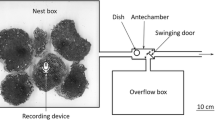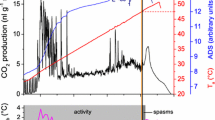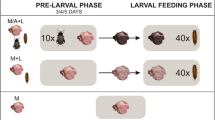Abstract
Social insects can modulate body temperature to increase foraging efficiency; however, little is known about how the relative value of protein resources affects forager body temperature. Such regulation may be important given that colony growth is often limited by protein availability. In this paper, we present what are, to our knowledge, the first data for social insects showing that thoracic temperatures (T th) of foragers increase with the protein content of food resources. In an introduced population of western yellowjacket (Vespula pensylvanica), we measured T th of foragers collecting high-quality protein (100% canned chicken) and low-quality protein (50% canned chicken, 50% indigestible alpha-cellulose by volume) at different ambient air temperatures (T a). Wasps foraging on 100% chicken consistently exhibited higher T th compared to wasps foraging on 50% chicken. After correcting for T a, the mean T th for wasps collecting 100% chicken were 1.98°C higher than those of individuals collecting 50% chicken. We suggest that this mechanism may increase foraging efficiency in this and other social wasp species.


Similar content being viewed by others
References
Allen ME (1989) Nutritional aspects of insectivory. PhD dissertation. Michigan State University, East Lansing, MI
Bertram SM, Gorelick R, Fewell JH (2003) Colony response to graded resource changes: an analytical model of the influence of genotype, environment, and dominance. Theor Popul Biol 64:151–162
Coelho JR (1991) The effect of thorax temperature on force production during tethered flight in honeybee (Apis mellifera) drones, workers, and queens. Physiol Zool 64:823–835
Coelho JR, Ross AJ (1996) Body temperature and thermoregulation in two species of yellowjackets, Vespula germanica and V. maculifrons. J Comp Physiol B 166:68–76
Dyer FC (2002) The biology of the dance language. Annu Rev Entomol 47:917–949
Dyer FC, Seeley TD (1987) Interspecific comparisons of endothermy in honeybees (Apis)—deviations from the expected size-related patterns. J Exp Biol 127:1–26
Esch H (1976) Body-temperature and flight performance of honey bees in a servo-mechanically controlled wind-tunnel. J Comp Physiol 109:265–277
Gambino P (1990) Mark recapture studies on Vespula pensylvanica (Saussure) queens (Hymenoptera, Vespidae). Pan-Pac Entomol 66:227–231
Gambino P (1992) Yellowjacket (Vespula pensylvanica) predation at Hawaii volcanoes and Haleakala National Parks: identity of prey items. Proc Hawaii Entomol Soc 31:157–164
Gruner DS, Foote D (2000) Management strategies for western yellowjackets in Hawaii. Report to the Hawaii Secretariat for Conservation Biology
Heinrich B (1984) Strategies of thermoregulation and foraging in 2 vespid wasps, Dolichovespula maculata and Vespula vulgaris. J Comp Physiol B 154:175–180
Heinrich B (1993) Hot-blooded insects: mechanisms and evolution of thermoregulation. Harvard University Press, Cambridge, MA
Hendrichs J, Katsoyannos BI, Wornoayporn V, Hendrichs MA (1994) Odour-mediated foraging by yellowjacket wasps (Hymenoptera: Vespidae): predation on leks of pheromone-calling Mediterranean fruit fly males (Diptera: Tephritidae). Oecologia 99:88–94
Herrera CM (1997) Thermal biology and foraging responses of insect pollinators to the forest floor irradiance mosaic. Oikos 78:601–611
Hodges D (1984) The pollen loads of the honeybee: a guide to their identification by colour and form, 1st edn. International Bee Research, London
Hunt JH, Baker I, Baker HG (1982) Similarity of amino acids in nectar and larval saliva—the nutritional basis for trophallaxis in social wasps. Evolution 36:1318–1322
Hunt JH, Buck NA, Wheeler DE (2003) Storage proteins in vespid wasps: characterization, developmental pattern, and occurrence in adults. J Insect Physiol 49:785–794
Kay A (2002) Applying optimal foraging theory to assess nutrient availability ratios for ants. Ecology 83:1935–1944
Kovac H, Stabentheiner A (1999) Effect of food quality on the body temperature of wasps (Paravespula vulgaris). J Insect Physiol 45:183–190
Lee KP, Raubenheimer D, Simpson SJ (2004) The effects of nutritional imbalance on compensatory feeding for cellulose-mediated dietary dilution in a generalist caterpillar. Physiol Entomol 29:108–117
Malham JP, Rees JS, Alspach PA, Beggs JR, Moller H (1991) Traffic rate as an index of colony size in Vespula wasps. N Z J Zool 18:105–109
Michener CD, Michener MH (1951) American social insects. Van Nostrand Rheinhold, New York
Nieh JC, Sanchez D (2005) Effect of food quality, distance and height on thoracic temperature in the stingless bee, Melipona panamica. J Exp Biol 208:3933–3943
Nieh JC, Contrera AAL, Rangell J, Imperatriz-Fonseca VL (2003) Effect of food location and quality on recruitment sounds and success in two stingless bees, Melipona mandacaia and Melipona bicolor. Behav Ecol Sociobiol 55:87–94
Nieh JC, Leon A, Cameron S, Vandame R (2006) Hot bumble bees at good food: thoracic temperature of feeding Bombus wilmattae foragers is tuned to sugar concentration. J Exp Biol 209:4185–4192
Pankiw T, Page Jr RE (2000) Response thresholds to sucrose predict foraging division of labor in honeybees. Behav Ecol Sociobiol 47:265–267
Pankiw T, Rubink WL (2002) Pollen foraging response to brood pheromone by Africanized and European honey bees (Apis mellifera L.). Ann Entomol Soc Am 95:761–767
Pernal SF, Currie RW (2001) The influence of pollen quality on foraging behavior in honeybees (Apis mellifera L.). Behav Ecol Sociobiol 51:53–68
Reid BL, Macdonald JF (1986) Influence of meat texture and toxicants upon bait collection by the German yellowjacket (Hymenoptera, Vespidae). J Econ Entomol 79:50–53
Scheiner R, Page RE, Erber J (2004) Sucrose responsiveness and behavioral plasticity in honey bees (Apis mellifera). Apidologie 35:133–142
Schmaranzer S, Stabentheiner A (1988) Variability of the thermal behavior of honeybees on a feeding place. J Comp Physiol B 158:135–141
Seeley TD, Camazine S, Sneyd J (1991) Collective decision-making in honey bees—how colonies choose among nectar sources. Behav Ecol Sociobiol 28:277–290
Stabentheiner A (2001) Thermoregulation of dancing bees: thoracic temperature of pollen and nectar foragers in relation to profitability of foraging and colony need. J Insect Physiol 47:385–392
Stabentheiner A, Hagmüller K (1991) Sweet food means “hot dancing” in honeybees. Naturwissenschaften 78:471–473
Underwood BA (1991) Thermoregulation and energetic decision-making by the honeybees Apis cerana, Apis dorsata and Apis laboriosa. J Exp Biol 157:19–34
Waddington KD (1990) Foraging profits and thoracic temperature of honey-bees (Apis mellifera). J Comp Physiol B 160:325–329
Waddington KD, Nelson CM, Page RE (1998) Effects of pollen quality on the dance of foraging honey bees. Anim Behav 56:35–39
Woods WA, Heinrich B, Stevenson RD (2005) Honeybee flight metabolic rate: does it depend upon air temperature? J Exp Biol 208:1161–1173
Acknowledgments
We would like to thank Cause Hanna and David Foote (USGS-HAVO) for their help with yellowjacket nest location. We are grateful for the assistance of Shannon Wilson and John Wilson in pilot studies. Data were collected under permit HAVO-2005-SCI-0044. The comments of anonymous reviewers substantially improved the manuscript. EEW was supported in part by the Jeanne Marie Messier Memorial Fund and a NSF DDIG (NSF DEB-0608397).
Author information
Authors and Affiliations
Corresponding author
Rights and permissions
About this article
Cite this article
Eckles, M.A., Wilson, E.E., Holway, D.A. et al. Yellowjackets (Vespula pensylvanica) thermoregulate in response to changes in protein concentration. Naturwissenschaften 95, 787–792 (2008). https://doi.org/10.1007/s00114-008-0384-x
Received:
Revised:
Accepted:
Published:
Issue Date:
DOI: https://doi.org/10.1007/s00114-008-0384-x




